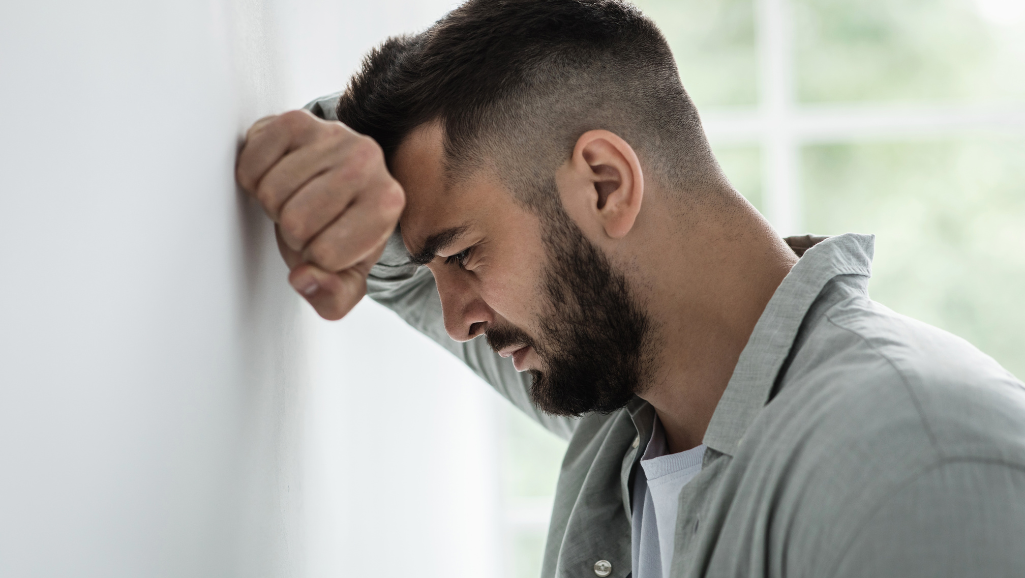Millions of Americans face a relentless cycle where overwhelming thoughts trigger physical tension, making daily life harder. Nearly 40 million U.S. adults experience this challenge each year, often feeling stuck in patterns of worry and exhaustion.
From workplace burnout to parenting pressures, modern demands amplify mental health struggles. But breaking free is possible. This guide offers actionable strategies, not just theories, to help you regain control.
Your breakthrough starts here. Discover science-backed methods to identify triggers, refocus priorities, and build resilience. Let’s transform stress into strength—one step at a time.
Key Takeaways
Does Anxiety Cause Stress.
- Over 40 million U.S. adults struggle with anxiety yearly
- Real-world stressors like work and parenting fuel the cycle
- Practical solutions exist beyond temporary relief
- Professional support can accelerate progress
- Small daily changes create lasting impact
Understanding Stress and Anxiety: Key Differences
Many people confuse stress and anxiety, but these experiences have distinct triggers and timelines. One fades when the pressure lifts; the other sticks around, coloring everyday life with unease.
What Is Stress? The Body’s Alarm System
Stress is your body’s reaction to immediate challenges—a work deadline, traffic jam, or heated argument. It’s short-lived, like a fire alarm blaring during danger but silencing afterward.
Cortisol, the stress hormone, fuels this fight-or-flight response. Muscles tense, hearts race, and focus sharpens. Once the situation passes, your system resets.
What Is Anxiety? When Worry Lingers
Anxiety, however, acts like a smoke detector that won’t shut off. It’s persistent worry—about driving, health, or hypothetical disasters—with no clear event triggering it.
Research from Johns Hopkins reveals 38% of chronically stressed individuals develop anxiety within two years. The amygdala, your brain’s fear center, stays hyperactive, prolonging discomfort.
- Shared symptoms: 76% experience muscle tension; 63% face sleep disruptions
- Chronic stress (>3 months) raises heart disease risk by 50%
- Disorder threshold: Daily life disruption + prolonged symptoms (DSM-5 criteria)
“Stress is the weight of today; anxiety is the shadow of tomorrow.”
Does Anxiety Cause Stress? The Vicious Cycle Explained
Persistent unease doesn’t just linger—it actively reshapes how the body handles pressure. Yale researchers found that anxiety disorders spike stress hormones by 28%, creating a loop where worry and physical strain feed each other.
Neuroimaging reveals overlapping brain patterns in chronic cases. The amygdala, responsible for fear, stays hyperactive. Meanwhile, dopamine pathways reinforce avoidance behaviors, like a marketing director who missed promotions due to performance dread.
Cortisol plays a double role. Initially, it sharpens focus. Over time, it erodes resilience. APA data shows chronic sufferers endure 2.3x more stress episodes than others.
“The ‘Worry Window’ shrinks when hypothetical fears become today’s burdens.”
Breaking free starts with recognizing the cycle. Small steps—like scheduling “worry time” or reframing thoughts—can reset the brain’s response to pressure. Prioritizing mental health isn’t indulgence; it’s science-backed prevention.
Recognizing the Symptoms: Stress vs. Anxiety
Your body sends signals when stress or worry take hold—learning to read them changes everything. While 74% of people notice tension headaches during stressful periods, 41% report numbness when unease lingers. These physical symptoms act as your personal health alert system.
Physical Signs You Shouldn’t Ignore
Stress often shows through clenched jaws (82%) or stiff shoulders—your body bracing for short-term challenges. Anxiety triggers different responses like tingling hands or dizziness, as blood flow shifts away from extremities.
MIT’s brain research reveals how error-related negativity (ERN) spikes in anxious individuals. This explains why some feel like every decision carries danger. A simple body scan exercise helps identify tension:
- Close your eyes and notice areas of pressure
- Breathe into tight spots for 4 seconds
- Release tension with each exhale
Emotional and Cognitive Red Flags
Stress brings situational irritability—snapping at slow drivers or overflowing inboxes. Anxiety breeds persistent dread, with 33% experiencing derealization (feeling disconnected from reality).
ER nurses recommend the 2-minute rule: Chest pain lasting longer needs immediate attention. As one trauma specialist notes:
“When rapid breathing combines with BP over 180/120, that’s your signal to call 911—not Google.”
Tracking these emotional symptoms helps distinguish temporary stress from chronic concerns. Your response time matters more than the symptoms themselves.
Common Triggers That Fuel Both Stress and Anxiety
Certain life events and daily routines can quietly intensify emotional strain. Recognizing these triggers is the first step toward regaining balance. Some stem from major changes, while others build up through small, repeated habits.
Life Changes That Tip the Scales
Major transitions often create waves of pressure, even positive ones. Financial strain tops the list, affecting 68% of adults. Relationship shifts—divorce, caregiving, or family conflicts—follow closely at 57%.
Health scares trigger 49% of cases, especially when facing chronic conditions. A modified Holmes-Rahe scale helps assess your personal risk factors:
- Job loss or career changes (scored 47 points)
- Relocation or housing instability (20 points)
- Family additions like newborns (39 points)
“Perfectionism isn’t excellence—it’s fear wearing a disguise.”
Daily Habits That Amplify Discomfort
Small choices compound over time. Three daily coffees spike unease risk by 34%, while four-hour screen sessions raise stress markers 22%. Alcohol and late-night scrolling often backfire, worsening sleep quality.
Hidden culprits like vitamin D deficiency or undiagnosed sleep apnea frequently go unnoticed. Swap problematic patterns with these alternatives:
- Matcha instead of afternoon espresso
- Digital sunset—no screens 90 minutes before bed
- 10-minute walks to reset nervous system
For deeper insights, explore professional guidance on identifying triggers. Lasting management starts with awareness—you’ve already begun.
When Stress and Anxiety Become Disorders
When everyday worries escalate into constant dread, the line between normal stress and clinical disorders becomes clear. Nearly 30% of adults will experience this shift, where temporary concerns transform into persistent health challenges.
Generalized Anxiety Disorder (GAD)
GAD involves excessive worry lasting over six months, with physical symptoms like muscle tension and fatigue. Diagnostic interviews often reveal:
- Difficulty controlling worry about multiple life areas
- Restlessness or feeling “on edge” most days
- Sleep disturbances affecting work performance
Neuroplasticity research offers hope—consistent treatment can rewire neural pathways in 8-12 weeks. Cognitive Behavioral Therapy shows particular promise for reframing catastrophic thinking patterns.
Panic Disorder and Chronic Stress
Unlike situational stress, panic attacks strike unpredictably, affecting 2.7% of U.S. adults. Nocturnal episodes wake 35% of sufferers with racing hearts and breathlessness.
“Chronic stress shortens telomeres—the protective caps on DNA—accelerating cellular aging by up to 10 years.”
Emerging interventions like vagus nerve stimulation show potential for resetting stress responses. Watch for these red flags requiring professional help:
- Unintentional weight loss exceeding 10%
- Withdrawal from social connections
- Persistent inability to concentrate
Early intervention transforms outcomes. What feels unmanageable today often responds remarkably to evidence-based care.
Proven Techniques to Break the Cycle
Simple yet powerful techniques can reset your body’s response to pressure. Whether you need instant calm or lasting change, these evidence-based methods offer real relief. The key lies in combining immediate tools with gradual strategies for sustainable results.
Immediate Relief: Breathing and Grounding
When overwhelm strikes, the 4-7-8 breathing method helps 57% of people within minutes. Inhale for 4 counts, hold for 7, exhale for 8. Navy SEALs use a similar approach—box breathing—with one twist: exhale through pursed lips to activate the vagus nerve.
Grounding activities anchor you in the present. Try this sensory exercise:
- Name 5 things you see
- Identify 4 textures you feel
- Notice 3 sounds around you
- Detect 2 scents in the air
- Recognize 1 taste in your mouth
Long-Term Strategies: Lifestyle Shifts
A 12-week overhaul plan works best with small steps. Week 1 might focus on hydration, week 4 on sleep hygiene. Research shows consistent exercise lowers relapse risk by 42%—start with 10-minute walks if new to fitness.
Journaling helps track triggers and emotions. Use these prompts:
- What drained my energy today?
- When did I feel most at peace?
- What small win can I celebrate?
“HRV biofeedback wearables provide real-time data to optimize stress recovery.”
The Power of Professional Support
Cognitive Behavioral Therapy (treatment) boasts 60-80% success rates by reframing thought patterns. Alternatives like ACT and DBT take 8-12 weeks to show impact. A mental health professional can recommend the best approach for your needs.
Tech tools complement traditional help:
- Anxiety-tracking apps identify symptom patterns
- Guided meditation programs build resilience
- Relapse prevention plans prepare for high-pressure periods
Remember—progress isn’t linear. Some days will test your new ways to manage stress. That’s when your toolkit matters most.
When to Seek Help: Signs You Need More Support
Recognizing when to ask for professional help can transform your mental health journey. Persistent thoughts that disrupt work or relationships often signal deeper situations needing attention. Your body knows before your mind admits it.
- More than 3 panic attacks weekly
- Withdrawal from family and social activities
- Physical symptoms like chest pain lasting over 10 minutes
Evidence shows 76% see improvement within 8-10 therapy sessions. SSRIs take 4-6 weeks for full effect, but combined treatment approaches work fastest. Progress isn’t overnight—it’s consistent.
“Daily function improving 30% means you’re on track—celebrate small wins.”
A mental health professional can customize your care plan. Many clinics offer sliding-scale fees, and most insurers now cover teletherapy. You deserve support that fits your life.
For immediate help, contact:
- 988 Suicide & Crisis Lifeline (call/text 988)
- Crisis Text Line: Text HOME to 741741
- Your primary care doctor for referrals
Conclusion: Taking Back Control Starts Today
Small daily choices create powerful shifts in mental health—start today. Commit to a 21-day challenge: try the 4-7-8 breathing method each morning, journal nightly, and take brisk walks. Research shows 89% see improvement within six months.
Track progress with our free Progress Tracker worksheet. Celebrate small wins—they add up. As one therapist notes, “Your calm is closer than your last panic attack.”
Ready for the first step? Watch this guided breathing exercise. For more inspiration, explore proven mindset strategies.
You’ve got this. Every effort counts.











